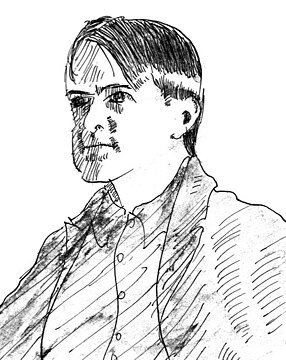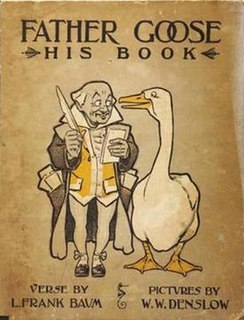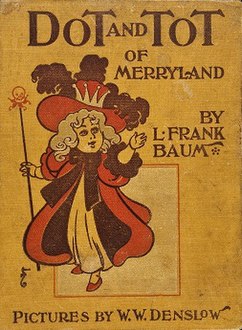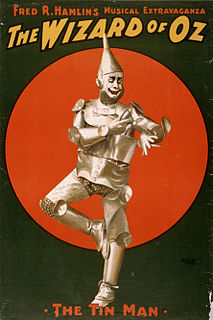First edition | |
| Author | L. Frank Baum |
|---|---|
| Illustrator | Maginel Wright Enright John R. Neill |
| Country | United States |
| Language | English |
| Genre | Poetry, Humor, Fantasy, Drama |
| Publisher | Reilly & Britton |
Publication date | 1910 |
| Media type | Print (hardcover) |
| Pages | 196 pp. |
L. Frank Baum's Juvenile Speaker: Readings and Recitations in Prose and Verse, Humorous and Otherwise is an anthology of literary works by L. Frank Baum, author of the Oz books. The book was first published in 1910, with illustrations by veteran Baum artists John R. Neill and Maginel Wright Enright; a subsequent 1912 edition was retitled Baum's Own Book for Children. [1] The book constitutes a complex element in the Baum bibliography. [2]

Lyman Frank Baum was an American author chiefly famous for his children's books, particularly The Wonderful Wizard of Oz and its sequels. He wrote 14 novels in the Oz series, plus 41 other novels, 83 short stories, over 200 poems, and at least 42 scripts. He made numerous attempts to bring his works to the stage and the nascent medium of film; the 1939 adaptation of the first Oz book would become a landmark of 20th-century cinema. His works anticipated such century-later commonplaces as television, augmented reality, laptop computers, wireless telephones, women in high-risk and action-heavy occupations, and the ubiquity of advertising on clothing.

John Rea Neill was a magazine and children's book illustrator primarily known for illustrating more than forty stories set in the Land of Oz, including L. Frank Baum's, Ruth Plumly Thompson's, and three of his own. His pen-and-ink drawings have become identified almost exclusively with the Oz series. He did a great deal of magazine and newspaper illustration work which is not as well known today.
Maginel Wright Enright Barney was an American children's book illustrator and graphic artist. She was the younger sister of Frank Lloyd Wright, architect, and the mother of Elizabeth Enright, children's book writer and illustrator.
Contents
Baum intended the anthology for schools, to be used in instruction in public speaking. The collection includes versions of previously published material from Baum's Oz books, Father Goose , and other works, plus new selections like Prince Marvel, a short play for child actors based on The Enchanted Island of Yew .

Father Goose: His Book is a collection of nonsense poetry for children, written by L. Frank Baum and illustrated by W. W. Denslow, and first published in 1899. Though generally neglected a century later, the book was a groundbreaking sensation in its own era; "once America's best-selling children's book and L. Frank Baum's first success," Father Goose laid a foundation for the writing career that soon led to The Wonderful Wizard of Oz and all of Baum's later work.

The Enchanted Island of Yew: Whereon Prince Marvel Encountered the High Ki of Twi and Other Surprising People is a children's fantasy novel written by L. Frank Baum, illustrated by Fanny Y. Cory, and published by the Bobbs-Merrill Company in 1903.
One of the selections is "Little Bun Rabbit," the final piece in Baum's Mother Goose in Prose from 1897. The protagonist in Baum's version of the nursery rhyme is a little girl who can talk to animals – named Dorothy. When Baum reprinted in story in his Juvenile Speaker, he changed the character's name to Doris, to forestall confusion with Dorothy Gale from The Wonderful Wizard of Oz . [3] [4]

Mother Goose in Prose is a collection of twenty-two children's stories based on Mother Goose nursery rhymes. It was the first children's book written by L. Frank Baum, and the first book illustrated by Maxfield Parrish. It was originally published in 1897 by Way and Williams of Chicago, and re-released by the George M. Hill Company in 1901.

Dorothy Gale is a fictional character created by American author L. Frank Baum as the main protagonist in many of his Oz novels. She first appears in Baum's classic children's novel The Wonderful Wizard of Oz (1900) and reappears in most of its sequels. In addition, she is the main character in various adaptations, notably the classic 1939 film adaptation of the novel, The Wizard of Oz.

The Wonderful Wizard of Oz is an American children's novel written by author L. Frank Baum and illustrated by W.W. Denslow, originally published by the George M. Hill Company in Chicago on May 17, 1900. It has since seen several reprints, most often under the title The Wizard of Oz, which is the title of the popular 1902 Broadway musical adaptation as well as the iconic 1939 musical film adaptation.
Baum made other revisions in his reprinted texts. One example: the 20th chapter in The Wonderful Wizard, "The Dainty China Country," was revised into a stand-alone tale, "In Chinaland;" and Baum removed the detail in which the Cowardly Lion accidentally destroys a small china church with his tail. [5]











